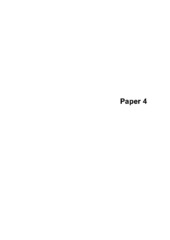| dc.contributor.author | Arango, Santiago Aramburo | eng |
| dc.date.accessioned | 2006-12-28T11:40:09Z | |
| dc.date.available | 2006-12-28T11:40:09Z | |
| dc.date.issued | 2006-12-15 | eng |
| dc.identifier.isbn | 82-308-0290-4 (print version) | |
| dc.identifier.uri | https://hdl.handle.net/1956/2027 | |
| dc.description.abstract | This thesis studies cycles in commodity markets. Such fluctuations have significant adverse effects onconsumers and producers. The properties of commodity price fluctuations are well known. However,there is considerable disagreement about the underlying causes of market fluctuations. Understandingsuch cycles is essential for policy analysis. We analyze the case of recently deregulated electricitymarkets, where several authors have expressed a concern that capacity cycles may emerge. Thepotential occurrence of cycles represents a major threat to electricity security, since there could beperiods with insufficient capacity to satisfy demand followed by periods with excess capacity andunsustainably low prices.Traditional economic literature argues that oscillations are caused by external shocks. We explore analternative explanation that comes from the internal structure of the system. The method is laboratoryexperiments. To link to the existing literature we start by investigating the simplest economic model ofcycles (the Cobweb model) with standard conditions, linear demand, and constant costs. Step by step,we add complexity (and realism) to the simple model. We introduce long lifetimes of productioncapacity and then we introduce a two period investment lag in addition to long lifetimes. Consistentwith previous experiments and the rational expectations hypothesis, we find no evidence of cycles inthe basic design and in the capacity lifetime treatment. Average prices are close to Cournot Nashequilibrium with a bias towards competitive prices. In the investment lag treatment, however, varianceand autocorrelation analysis indicate cyclical tendencies.In a follow up experiment we introduce a constant price elasticity with dynamic demand adjustment.The experiment gives rise to larger and asymmetric fluctuations similar to observed commodity prices(e.g. sugar and coffee prices). In a third experiment, we increase the frequency of decisions. Weobserve oscillatory behaviour in investment activity and prices. The cyclical tendency is stronger thanin the previous experiments, and the results corroborate assumptions made in previous simulationstudies of electricity markets. In a fourth paper, we look at empirical evidence of fluctuations in someelectricity markets in South America. While the time-series are not long enough to conclude that thereare systematic fluctuations, we observe that both Brazil and Chile have experienced very small reservemargins, electricity supply crises, and considerable shortages of electricity. The likely cause is lack ofinvestments in new generation capacity. Argentina and Colombia have high reserve margins and verylow spot prices, largely because of the deep recessions in their respective economies.The thesis contributes to a better understanding of endogenous causes of market fluctuations. Thisshould call for an increased interest in market models that include supply and demand side dynamics.Also, the findings should serve as a motivation to search for alternative stabilising policies in existingmarkets, particularly in markets where deregulation is considered. | en_US |
| dc.format.extent | 240216 bytes | eng |
| dc.format.extent | 570992 bytes | eng |
| dc.format.extent | 396874 bytes | eng |
| dc.format.extent | 432199 bytes | eng |
| dc.format.extent | 383299 bytes | eng |
| dc.format.mimetype | application/pdf | eng |
| dc.format.mimetype | application/pdf | eng |
| dc.format.mimetype | application/pdf | eng |
| dc.format.mimetype | application/pdf | eng |
| dc.format.mimetype | application/pdf | eng |
| dc.language.iso | eng | eng |
| dc.publisher | The University of Bergen | eng |
| dc.relation.haspart | Paper I: Arango, Santiago, 2006, Cyclical behaviour, a function of market complexity? Expanding the cobweb experiment. Draft version. | eng |
| dc.relation.haspart | Paper II: Arango, Santiago, 2006, Asymmetric commodity cycles: Evidence from an experimental market. Draft version. | eng |
| dc.relation.haspart | Paper III: Arango, Santiago, 2006, Cyclical Behaviour in Electricity markets: An Experimental study. Draft version. | eng |
| dc.relation.haspart | Paper IV: Utilities Policy 14(3), Arango, Santiago; Larsen, E. R. & Isaac Dyner, Lessons from deregulation: Understanding electricity markets in South America, pp. 196-207. Copyright 2006 Elsevier Ltd. Reproduced with permission. Published version. The published version is also available at: <a href="http://dx.doi.org/10.1016/j.jup.2006.02.001"target="blank"> http://dx.doi.org/10.1016/j.jup.2006.02.001</a> | eng |
| dc.subject | Commodity Cycles | eng |
| dc.subject | Investment Behaviour | eng |
| dc.subject | Deregulation | eng |
| dc.subject | Cycles in Electricity Markets | eng |
| dc.subject | Perfect Rationality | eng |
| dc.subject | Bounded Rationality | eng |
| dc.subject | System dynamics | eng |
| dc.subject | Experimental Economics | eng |
| dc.title | Essays on commodity cycles based on expanded Cobweb experiments of electricity markets | eng |
| dc.type | Doctoral thesis | en_US |
| dc.subject.nsi | VDP::Samfunnsvitenskap: 200::Samfunnsgeografi: 290 | nob |




